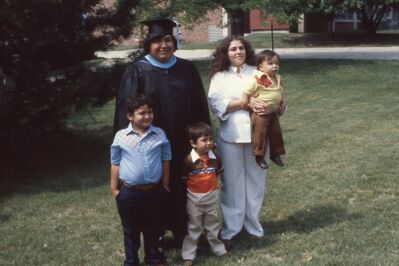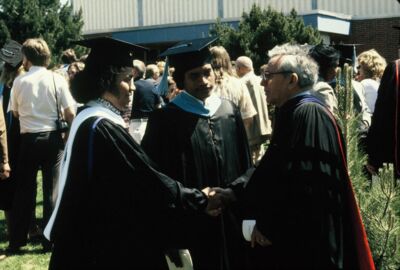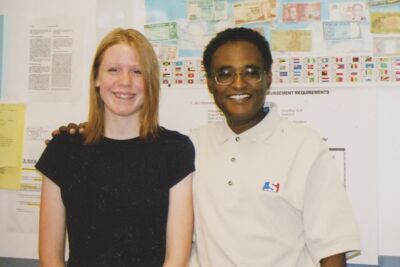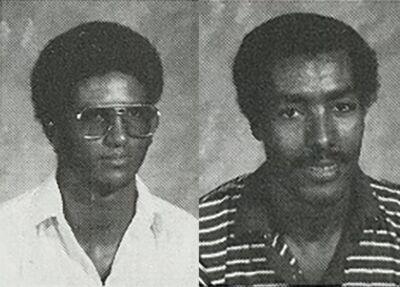
The Legacy of a Diversified Student Body
Story: Jerry Pfabe
Photos: Courtesy of Concordia Archives
Several programs at Concordia contributed to a more culturally diverse campus.
Among the surnames in the first Concordia graduation class of 1909 were Dittmar, Kühnert, Grundmann, Pflüger and Klawitter. These names reflected the dominant German background of students in Concordia’s early history. In the 1970s and ‘80s, however, alongside the German surnames called at commencement were names such as Risingsun, Ngirailab, Kabua, Iyassu and Gebreyhannes, representing new populations of Native American, Micronesian and Eritrean students and a new wave of cultural diversity on campus.
The Center for Indian Ministries and Studies (CIMS)
In September 1972 Concordia Teachers College and the Montana, Wyoming and Nebraska Districts of The Lutheran Church—Missouri Synod (LCMS) established the Center for Indian Ministries and Studies (CIMS). The CIMS was created to proclaim the Gospel among Native American people on reservations and, in turn, to enhance knowledge of Native American cultures and traditions among people within the LCMS. The first coordinator of the program was Ralph Redfox ’72 from the Northern Cheyenne tribe, assisted by Ronald Wagoner ’67. The CIMS and Concordia Nebraska formed a partnership, in which Native American students attended Concordia for college, while Concordia students spent time on reservations, living with Native families and conducting programs such as Vacation Bible School.
Rev. Dennis Bauer ’78 learned about the CIMS program while he was a student at the St. Louis seminary. CIMS arranged a summer vicarage for Bauer at Busby, Montana, and he was eventually called to serve in Muddy Cluster on the Northern Cheyenne reservation. Forty years later, Bauer still serves the congregation, the Circle of Life. Bill Mason ’73 was the first Native American student to graduate from Concordia. After graduation, Mason taught at a Native American high school in Wyoming and served as a consultant to CIMS, and he currently serves as the president of Bauer’s Circle of Life congregation.
Students came to Concordia from several tribes, among them Northern Cheyenne and Crow. The CIMS staff of Ronald Wagoner and James Nelesen, a Concordia English professor, and later Rev. Alfred Ebel CO ’64 GR ’78, developed new courses for these students, such as Introduction to Christianity, Native American cultures and Anglo-American Culture. Many of the students knew little about the Christian faith.
The Concordia community also benefitted greatly from the CIMS, which encouraged Native American students to preserve and share their cultural identities with Concordia and Seward. In 1976 they began the Heritage Club. Students participated in and sponsored reservation Pow Wows. They had traditional Native American dinners for the community and created a small buffalo herd (six animals in 1980), assisted by T.R. Hughes, a local businessman.
CIMS ended in 1984 after having a positive impact on our campus, enriching the lives of Native American alumni and the Concordia community.

Micronesian Students
In the fall of 1974, Hannah Phillip ’87 and Evelyn Alex ’78 from the Marshall Islands enrolled in Concordia College, some 6,000 miles from their homes. They had learned about Concordia from Ken ’69 and Sue (Rettig) Robbins ’69, Concordia graduates who worked in the Peace Corps in the Marshall Islands. It started a chain reaction. By 1984 almost 60 students from the Marshall Islands had attended Concordia.
All faced challenges. Not only were they very far from their home islands and families, but they had to adjust to a very different climate. They grew up in a culture which was non-competitive and non-individualistic, very different from that in the United States. Some needed to upgrade their skills in English. However, when a survey asked if they would choose to come to Concordia if given the chance to do it all again, each of them said, “Yes.”
A core of Concordia faculty, among them Elden Duensing HS ’49 CO ’53, Marvin Plamann ’56, Dr. Richard Zwick HS ’51 CO ’58 and Dr. Martin Maehr HS ’50 CO ’51, were instrumental in the success of the Micronesian students. There were ESL and American culture courses and field trips, including to the Sandhills and even a feeder lot. Students did not appreciate the odor! Martin “Grandpa” Maehr led regular Bible studies with them in his home, and students prepared traditional Micronesian meals there.
The international students developed strong friendships with students from the United States. For example, Evelyn and Hannah had a strong relationship with Connie (Kirchner) Meyer CO ’78 GR ’06. They lived on the same dorm floor as first-year students. Connie tutored them in English and writing. She took them to her parents’ farm in Nebraska where they learned to fish and even drive a tractor.
Many of the grads went into teaching and other vocations in Micronesia. Joe Habuchmai CO ’79 GR ’85 taught at the College of Micronesia-FSM and later served as the director of academic programs. In 2003 he became Lieutenant Governor of Yap State. Abon Jeadrik ’81 assumed the role of city manager of the Kwajalein Atoll Local Government. His wife Gorine was director for preventive services at the Ebeye Hospital. Najio and Mela (Katjang) Loeak ’80 worked on the military base of Kawjalein Island; Najio, as a police officer and Mela as personnel manager at the Pan Am World Services. Patrick Korok ’78 worked in shipping and was the supervisor for the Stevedoring Company on Ebeye. His wife Priscilla taught in the Head Start Program. Moses Ngiralab CO ’81 GR ’86 served as chief academic officer at Alabama Lutheran College in Selma.
The program ended abruptly in 1984, not due to lack of interest on the part of students or Concordia, but due to finances, both governmental and local, concluding a vital intercultural program at Concordia.
Eritrean Students
Concordia was the college home for five students from Eritrea, Africa, during the 1970s and 1980s.
In 1977 Zerezghi (Zack) Iyassu ’79 was the first to arrive on campus. In his homeland, he taught and served as principal at Asmara Evangelical (Lutheran) High School. He was a third generation Lutheran. He left Eritrea both to enhance his knowledge and skills as a teacher and administrator and because of dangerous political conditions. Iyassu learned about Concordia from the Rev. Daniel Mattson, an LCMS missionary in Eritrea. Before leaving Ethiopia, Iyassu was engaged to Alganesh (Gebreyhannes) Iyassu ’86. She came to the United States in 1981, and the two married in July of that year. She earned a degree in business, and Zack received his bachelor’s degree in mathematics and physics. Iyassu taught for 14 years in Lansing, Michigan, and Chicago. Then he established the Choice Taxi Company in Chicago along with an insurance agency. He and Alga worked together in their firm.

Dr. Fickak (Fee) Habtes ’81 and Dr. Misghina Abraha ’85 were both students of Iyassu in Asmara. They were driven from their homes due to political violence and religious persecution and came to the U.S. as refugees. Habtes earned a bachelor’s in biology, then a doctorate in public administration from the University of Illinois at Springfield. He held administrative positions for the Illinois government in transportation, public health and veterans’ affairs. Habtes was the executive vice president and COO at Concordia College Alabama for two years. He retired but still serves as Chair of the Board of the Eritrean Development Corporation, working with grassroots organizations.

After graduating from Concordia in 1985, Abraha earned an M.D. degree from the Mayo Clinic School of Medicine and completed his residency in internal medicine at Mayo in 1993. He practices with the Minneapolis Veterans Affairs Health Care System in Minneapolis and is an assistant professor at the University of Minnesota Medical School.
Solomon Andemariam ’85 earned his Concordia degree in mathematics. He has worked in food operations in the D.C. area.
This year, Concordia is home to 34 international students from 18 different countries. The diversity programs of the ‘70s and ‘80s paved the way for these partnerships that continue to expand students’ understanding of the world and different cultures at Concordia and prepare international alumni to learn, serve and lead in the church and world.